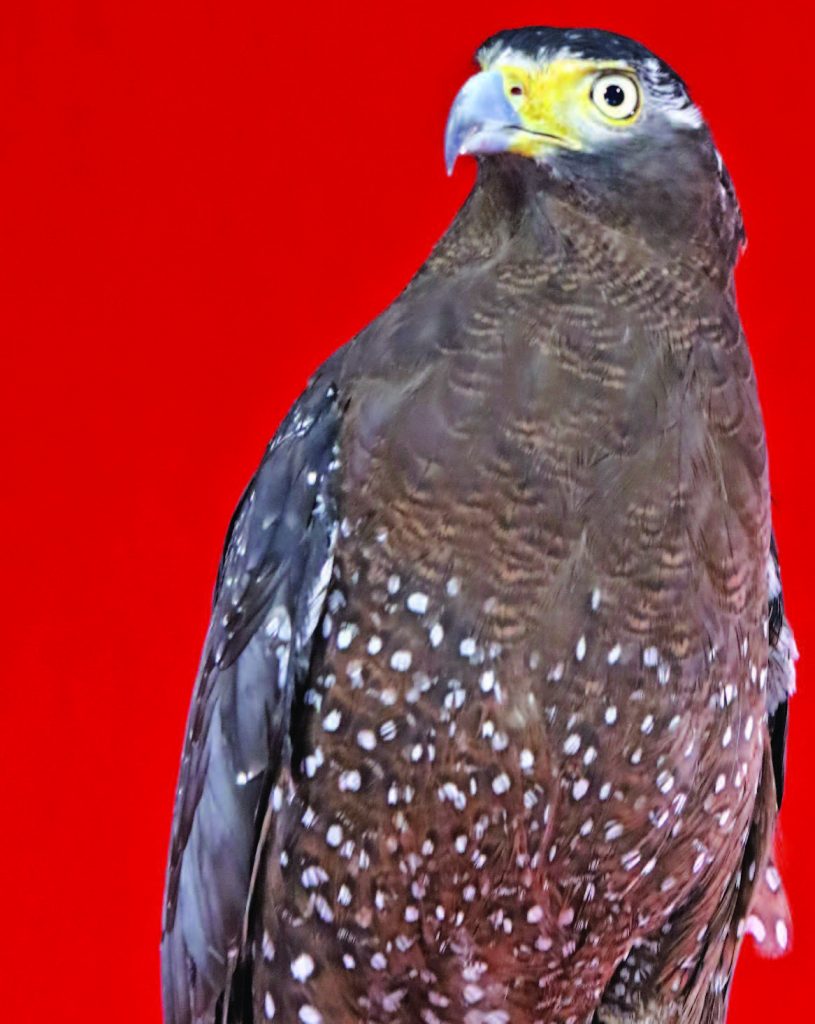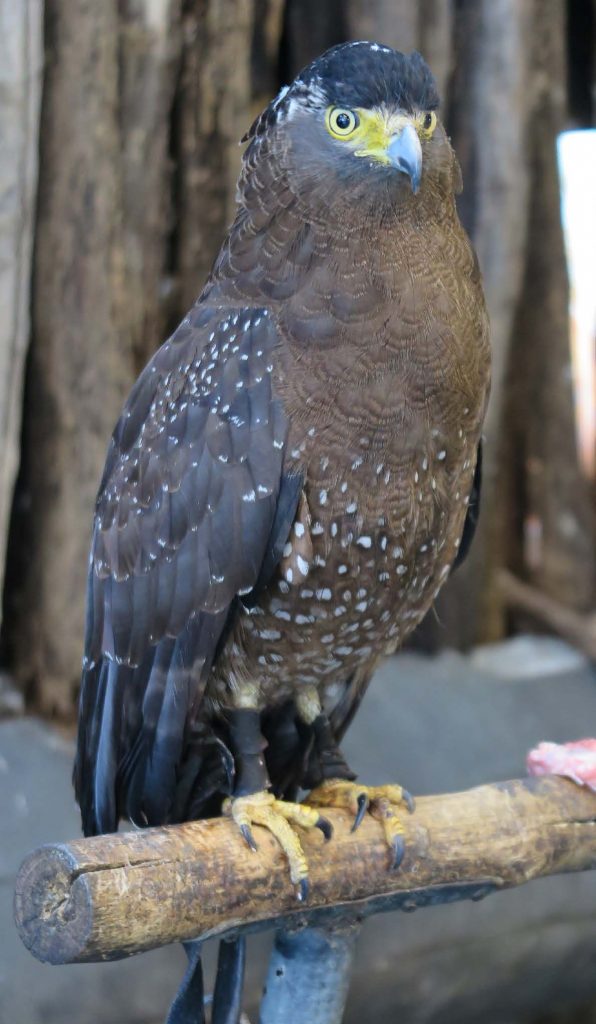Its coat, a majestic brown. Its eyes, a bright yellow. Its population, decreasing.
While the number of Philippine serpent eagles (Spilornis holospilus) has been in decline the past few years, the International Union for Conservation for Nature (IUCN) has not categorized the species as vulnerable on their Red List.

The Philippine serpent eagles, meanwhile, remain powerless in the face of habitat destruction. Many serpent eagles have been rescued by good Samaritans, turned over to the Department of Environment and Natural Resources (DENR), and released back into the wild. Some, like the Philippine serpent eagle in Patricia Nicolas’ care, are taken care of and raised privately.
Survival
The Philippine serpent eagle, endemic to the Philippines, is a largely sedentary species, normally found in primary and secondary forests, woodlands, and open land with scattered trees. It’s considered relatively small, growing up to 53 centimeters tall, with a wingspan of up to 120 centimeters.
Serpent eagles are mostly brown from above, with a black crown, and gray-brown cheeks and throat. They have white spots on their chests and wings (which have given the species the alternate name of Philippine crested serpent eagle), and their eyes and legs are yellow.
As its name suggests, serpent eagles have been known to feast on serpents and other reptiles, reported Rafael Antonio in a 2015 news article on Inquirer.net. However, they also feed on rodents and small mammals.

While their population has been decreasing, their species has not been declared vulnerable because vulnerable populations need to have had a decline greater than 30 percent over the last ten years or three generations. Each generation for Philippine serpent eagles lasts around 12 years, according to a 2018 online factsheet from BirdLife International.
The Philippine serpent eagle can reportedly be found in most parts of the country, except for Palawan.
Family
In an interview with Animal Scene, Nicolas said that her father was first to acquire their serpent eagle, who is “more or less 10 years old already.” Their eagle’s been in their family’s care since he was a baby. Nicolas says, “Bali, passion na talaga namin ng daddy ko na nag-aalaga ng exotic pets (Taking care of exotic pets has really been my and my daddy’s passion).” Aside from the serpent eagle, Nicolas takes care of snakes, crocodiles, and other reptiles.
She explains that taking care of the serpent eagle has become more of a hobby than anything else, considering that making money off of the eagle wouldn’t be sustainable. Whatever they would earn thanks to the eagle would immediately go back into the eagle’s maintenance — the animal’s food is especially expensive.
Grooming
As for grooming, Nicolas says that she makes sure to trim her eagle’s nails, at least for the sake of people who want to take pictures with him. Other than nail trimming sessions, Nicolas explains that her serpent eagle is pretty low-maintenance. He bathes on his own, with the water dish given to him. He also hasn’t had any cases of mites, but Nicolas is prepared to address any similar issues if these arise.

With nails fit to be around humans, Nicolas’ eagle doesn’t seem too bothered by all the attention he’s been being given. “Sanay lang siya sa tao (He’s just used to people),” she says. Nicolas has been bringing her serpent eagle to shows, birthday parties, exotic animal exhibits, and other events for more than five years.
Care
While bonding with an eagle may seem fun and, in Nicolas’ words, astig, she does warn that training an eagle is extremely challenging. Eagles must be trained every day, “kasi if lumagpas ka lang kunwari for two days hindi mo siya na-train, sometimes nagla-lapse and nag-iiba yung mood nila (because if you don’t train them for two days, sometimes their mood can change).”
She explains that many eagle trainers have different methods. Some man their eagles while they fly freely, while some even sleep next to their eagles at night.
Food
Nicolas feeds her Philippine serpent eagle different types of food, some of which being chicken heads. However, she also gives her eagle live food, “kasi minsan kailangan talaga nila yun (because sometimes they really need that).” Her serpent eagle isn’t a choosy eater, but he has gotten thinner with age. Because of his age, “hindi na siya pwedeng bulky (he can’t really be bulky).”
A matter of commitment
Given the Philippine serpent eagle’s demanding training and expensive maintenance, Nicolas believes that their companion humans must be dedicated and can ensure that they can totally take care of their eagle. “They have to be sure,” she says. This is because once a wild animal becomes used to the presence of humans, it will be undoubtedly difficult to release them back into the wild.

“So, if ever man na may mag-alaga tapos nag-decide na ‘ayaw ko na’, hindi na niya pwedeng pakawalan sa wild kasi it’s either mababaril or mahuhuli din ng ibang tao so pwedeng mamatay (If someone takes care of an eagle and then decides they don’t want to anymore, they can’t release the eagle into the wild because the eagle will probably only get shot or caught by other people, and will most likely die).” Nicolas emphasizes that taking care of an eagle is a lifelong commitment.
Yes, having a pet eagle is astig and is a great conversation-starter. Not a lot of people can say they go home to an eagle every day. But of all the things Nicolas loves about taking care of a Philippine serpent eagle, she considers his kindness the most valuable. “Sobrang swerte lang namin sakanya kasi sobrang bait (We really are so lucky because he’s so nice),” she says.
Nicolas explains that it’s an incredibly rewarding feeling to know that she’s taking care of a species whose population is of concern, and she’s taking care of him well. “Syempre yung kahit papaano meron kang mafi-feel na fulfillment if makikita mong okay yung hayop sa care mo and kumakain and nagta-thrive (Of course, you’ll feel a sense of fulfillment from seeing that the animal in your care is okay, is eating, and is thriving).”
Her eagle is currently healthy and free of illness. “As a hobbyist,” she says, that’s all there is to it. All she wants is to see her animals happy and healthy.
Personality
Nicolas believes that the Philippine serpent eagle’s attitude differentiates it from other species of birds. She considers herself lucky to have found her serpent eagle, because he continues to stay kind to people, “kahit hindi namin siya nailalabas for months, minsan years siyang hindi namin nae-expose sa mga tao (even if we don’t let him out for months, even years of not being exposed to people).”
People have likened her serpent eagle to a chicken because of his sweet nature. “Hindi siya yung usually aggressive at usually magni-nip na (He isn’t the usually aggressive type who would usually nip at humans).”
This appeared in Animal Scene magazine’s January 2019 issue.






